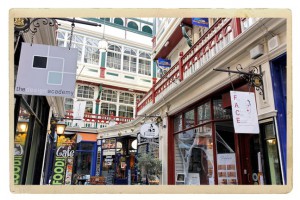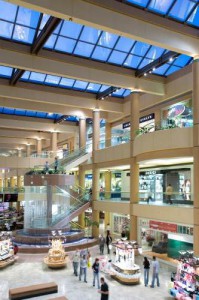Shopping Centre – I’ve Seen Better looking Factories
For some years now the old cattle market area to the north of Hereford’s city centre has been a disused and dilapidated eyesore but more recently over the last year or so it has been undergoing redevelopment. I viewed this in passing over the months and wondered just what form the final development would take as the scale of the buildings began to look progressively industrial and insensitive in such a significant position adjacent to the old city centre. The old cattle market itself, a single storey structure with two storeys at the perimeter, though dilapidated was in fact very similar in design to the Gloucester City Cattle Market, also now demolished, but regarded as a successful and innovative project at the time of its design as a result of the concrete barrel vault structure. The architect being John Prosser RIBA of the then City Architect’s Department headed by J. Wall RIBA.
Within the last few weeks there were signs that the new development was approaching completion with large logos prominent on the perimeter buildings facing onto the ring road and it became obvious that the development was in fact a new shopping centre called appropriately ‘The Old Market Shopping Centre’. I hadn’t been following the local Hereford news as we live some distance from the city, our shopping town being Monmouth only five miles away, and therefore I was a little surprised to discover that the development was that of a shopping centre as the area is effectively separated from the historic town centre by the ring road. I therefore took an early opportunity to pay a visit to The Old Market Shopping Centre in order to find out how the new development related to the existing historic city centre and to put my fears at rest about the scale and industrial appearance of this commercial development.
A quick search on Google and I was able to establish that the developers ‘Green and Partners’ boast that ‘Old Market, Hereford will be the only shopping and leisure scheme opening in the UK in 2014’. The development itself is basically ‘U’ shaped with a large parking area occupying the open side of the ‘U’. The developers further state that ‘
- Old Market will connect with the historic city centre of Hereford, the 300,000 sq ft development will benefit from 1,000 on site car parking spaces which combined with the tenants already secured will make this the prime retail pitch in Hereford benefitting from strong linkage to the existing retail offer.
I have no doubt that that the developers are correct in that the new shopping centre will be the prime retail pitch in Hereford which only goes to confirm my fears that there is likely to be a significant impact on the traders within the old city. However I do not see how there can be a strong linkage with the old centre because of the distance and the physical barrier of the ring road, Newmarket Street (see illustrations). The diagram in the developers brochure illustrates two improved pedestrian crossings at key points within the development linking to the old town but my experience just the other day in trying to cross the barrier of the ring road did not give me any confidence that this is likely to provide the promised continuity with the pattern of shopping within the old town. Notwithstanding the distance from the historic city centre, crossing a major traffic artery is a psychological as well as a physical barrier.
Heavy Traffic & Red Light Gambling
The development, as it is taking shape, is consistent with the illustrations within the developer’s brochure, and at the time of writing this piece it appears that ‘85% of the scheme has been pre let with anchors including an 83,500 sq. ft. Debenhams (The City’s only department store), a 23,000 sq. ft. Waitrose, a 20,000 sq. ft. Next and a 6 screen Odeon. With further lettings secured to TK Maxx, Outfit, River Island, Fat Face, Clarks, Prezzo, Nandos, CHIMICHANGA and Frankie & Bennys.
The new Debenhams will be a welcome addition to Hereford as indeed will Waitrose, but the question has to be asked ‘why was it not possible to incorporate such key features of the new proposals within the existing city centre? That this can be achieved successfully is illustrated by the new shopping mall in Cardiff which integrates well within the old city layout without sucking the life from the city’s main shopping area and its remarkable Regency Arcades.
Shopping centres have been in existence since Greco-Roman times. In ancient Greece the shopping area was known as the ‘Agora’ and the first shopping mall was probably built by the Emperor Trajan within Trajan’s Forum, and was a semi-circular building with a vaulted roof resembling a basilica. More recently the shopping centre or mall is an American import which we have now become used to, it is however disappointing that the lessons of such developments in the States have not been learned. America is after all a very large country often with scattered and very small population centres. Hardly surprising therefore that regional shopping centres would be necessary for a population that is essentially mobile and dependent on the automobile. Visiting Scottsdale in Arizona in the intense heat I, and it appeared many locals, found a level of air-conditioned comfort in using the Scottsdale Fashion Square with its cooling indoor waterfall (see link and below).
Elsewhere Carmel’s the Barnyard Shopping Village illustrates America’s capacity to bring variety to the shopping centre model designed for the automobile (see link). The United Kingdom however is densely populated and while village outlet centres (Ellesmere Port, Swindon Designer Outlet) have proven to be successful in serving a region, our historic towns and villages are frequently under threat from out of scale and insensitive development. In the case of the Old Market Shopping Centre it is clear that officers and councillors serving the appropriate committees of the Council gave full consideration to the development as it proceeded through the various stages leading to approval and ultimately construction. It is clear also that the many contentious issues created by the location and form of the development also were put before the committee for consideration, and that the council wrestled with the proposals is obvious from a reading of the minutes of the various meetings with commercial and aesthetic interests often at odds. As ever though, commercial considerations won the day. In particular the consideration that nationally only two urban regeneration projects had survived the economic downturn, Old Market Shopping Centre being one of them and that, Hereford would lose its dominance as a regional shopping centre unless additional retail outlets could be provided. There was also a full discussion about the contentious issue of the crossing of Newmarket Street and the distance from the historic centre. Rather less on the architectural quality of the proposals or the impact on the old centre and its existing traders. It is hard indeed to see how a local authority at this time of austerity could have withstood such a stampede of commercial and vested interest. For me though, belatedly I admit, a number of questions remain:
- What consideration was given to the architectural merit of the proposals and its ability to blend in with the scale of an ancient and historic city centre?
- What measures have been taken to deal with and monitor the effect of the impact on existing traders within the historic city and the potentially hazardous pedestrian crossings of Newmarket Street?
- Why is there no architect employed within the local authority who would have a role of advising on architectural matters (in particular the elevation to Edgar Street is an abomination)?
- To what extent was consideration given to the need to provide housing within the city centre area, perhaps on upper floors of small retail outlets, to ensure a vibrant town centre and social life at all times outside normal retail times?
I remain of the opinion that the distance from the existing historic centre and the nature of the physical barrier of Newmarket Street will make it difficult to absorb the new shopping centre into the infrastructure of the old city and in this respect I believe that hope has triumphed over reason. Time will tell!
Over the last few years Hereford City Centre has been invigorated as a result of pedestrianisation and perhaps partly as a result of a level of immigration from the EU the Centre enjoys at the moment a vibrant and colourful cafe society. Although traders in Widemark Street may benefit from increased footfall, overall I believe that this may be at risk from the new development. Above all why was it not possible to ensure that the new development be appropriately scaled to blend in with the historic city and less like a factory development? I have seen better looking factories. The Rubber factory at Brynmawr (now demolished) and designed by the Architects Cooperative-Partnership was in its time even visited and admired by Frank Lloyd Wright.
What is certain is that Hereford people and those who treasure the heritage of our cathedral cities will need to be vigilant to ensure that some of the forebodings that I have expressed do not come to pass. We must all do what we can: with a bow to Hereford’s MP, Jesse Norman, as Edmund Burke would have it ‘Nobody made a greater mistake than he who did nothing because he could do only a little’. Hence this particular Blog.






